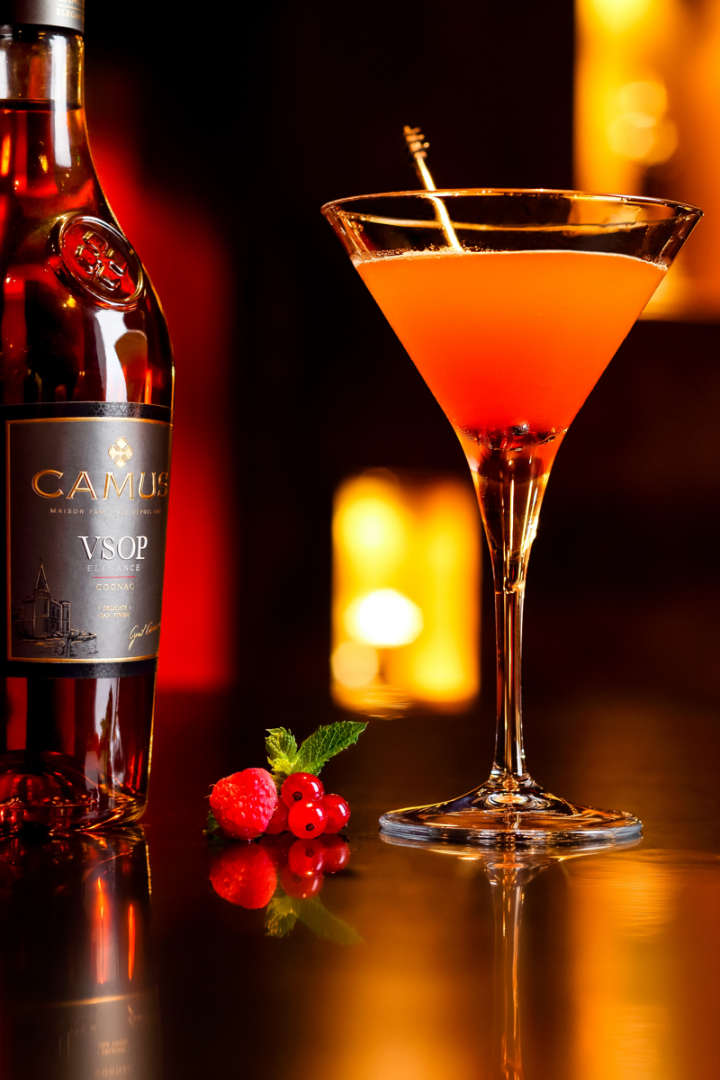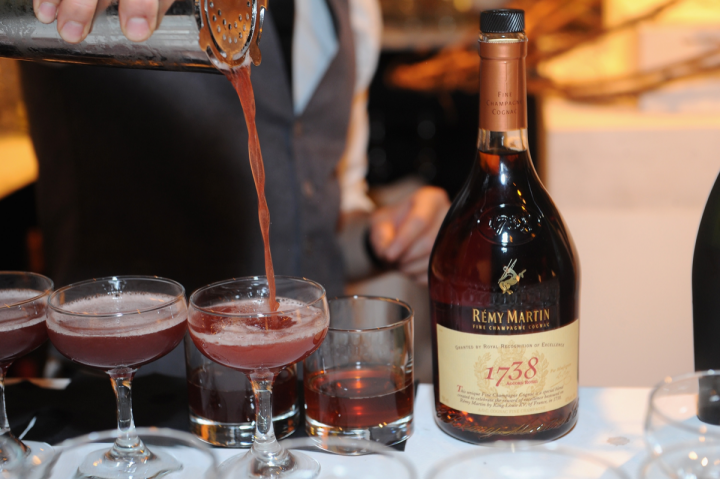
Cognac sales are up this year at the Skokie, Illinois–based chain Binny’s Beverage Depot. Specialty spirits buyer Brett Pontoni attributes the increase to a renewed focus on the U.S. market. Five years ago, Cognac shipments were being diverted to China from all over the globe as the country was hungry for all manner of upscale products. But in 2012, China’s government cracked down on excessive gifting and entertainment, preaching a new austerity. Sales of Cognac, along with many other luxury goods, plummeted.
Seesawing demand from Asia has left U.S. warehouses with bigger Cognac stocks at cheaper prices than they’ve had in years, and the marketplace is responding. Cognac volume in the United States advanced 7.7 percent to nearly 4 million cases in 2014—a record high. As Scotch and Bourbon sales started soaring a couple of years ago, whiskies began replacing brandy as the after-dinner drink of choice in many restaurants. While skeptics suggested that Cognac and whiskey couldn’t both enjoy rapid growth at the same time, the rising tide of brown spirits in America is sweeping Cognac with it.
“Cognac producers were thumbing their noses at the United States five years ago,” says Pontoni of Binny’s, which stocks nearly 200 Cognac SKUs. “They saw a pot of gold in China, and as a result, stocks were tight here, causing prices to rise. But now everything has changed. Supplies have loosened up and some pricing has been adjusted downward. Cognac is doing well as a result.”
A different kind of consumption is driving Cognac at the moment. Rodney Williams, executive vice president of spirits at Moët Hennessy USA, reports that the Hennessy brand is on course to gain nearly 20 percent in sales this year. He adds that younger millennials are increasingly asking for Cognac-based cocktails. The Sidecar, which comprises Cognac, triple sec liqueur, lemon juice and simple syrup, has emerged as a go-to drink in many venues. Sazeracs are also being made with Cognac as bartenders dig deeper into cocktail archives of the 19th century and find that the earliest mixed drinks featured Cognac rather than whiskey.
“We’re seeing millennials drinking Cognac in cocktails before the meal and even during the meal,” Williams says. “That trend is consistent with Asia, where Cognac is usually enjoyed with food.” He notes that consumers are drinking both Cognac and whisk(e)y—sometimes in the same evening. The result has been positive. “It’s been years since we’ve had this kind of growth,” Williams notes.

Dominant Brands
Not everybody has shared in that prosperity. The Cognac category is still top-heavy, with five brands dominating. Leader Hennessy advanced 9 percent to 2.54 million nine-liter case sales in 2014—representing a 64.1-percent share of the U.S. market—according to Impact Databank. Rémy Martin ranked second with a 4.8-percent gain to 650,000 cases. Those labels are followed by the Beam Suntory brands Courvoisier, which rose 2.4 percent to 420,000 cases, and Salignac, which fell 5.8 percent to 98,000 cases due to a shortage in stocks. At No. 5, Pernod Ricard USA’s Martell is in a rebound phase with an 18.5-percent gain to 77,000 cases last year. The brand is considered a cautionary tale among Cognac houses that decided to de-emphasize their stateside business three years ago in favor of China, and Pernod Ricard is now reintroducing it to American distributors.
There are more than a hundred Cognac houses in France, but most don’t export to the United States. Frapin, which has grown in France through 20 generations of family ownership, is one example of a small brand that’s trying to get a foothold here. After a stint with Palm Bay International, the label was delegated to Pacific Edge Wine & Spirits last year. Frapin offers its Cuvée 1888 Cognac ($7,000 a 750-ml. bottle), which contains pre-phylloxera distillate from the 1860s, along with a VSOP ($48) that comprises liquid aged between six and 10 years and the Château Fontpinot X.O. ($150) that features liquid up to 20 years old. Still, Frapin operates on the periphery of the category. “A small Cognac brand needs to be handled by specialty distributors,” says Alain Royer, vice president of development at Frapin parent company Renaud Cointreau. “Otherwise we’re lost in a big distributor’s portfolio.”
Some of the more ambitious brands have set up their own import businesses. Since 2011, Camus Cognac has been imported through its own CIL US Wines & Spirits in Fort Lauderdale, Florida. The company has seen Asian sales slump lately and executive vice president Jean-Denis Voin notes that the home country isn’t a reliable fallback, as just 4 percent of Cognac is sold in France. The spirit has always counted on export markets, especially the United States.
Camus offers the price-competitive variants V.S. ($25 a 750-ml. bottle) and VSOP (around $35), as well as high-end expressions like Extra Elegance ($350) and Rarissimes ($750). Its Masterpiece Collection Cuvée 5.150 ($5,000) pays homage to five generations of ownership by the Camus family and 150 years of operation. “We’re one of the largest small Cognac houses, but we’re not close to playing the same game as the big four,” Voin says. “Our approach requires retail training and hand-selling. We have to pick and choose where we sell. We’re big in places like California, Florida and Georgia.”

Room For Discovery
Another self-importer, Des Plaines, Illinois–based A. Hardy USA, projects that 2015 volume will be up close to 20 percent on just 25,000 cases. The company has identified niches ignored by bigger houses and introduced an Organic VSOP Cognac ($59 a 750-ml. bottle) that’s found placement at the Whole Foods chain. It will also soon offer a cask-strength VSOP called Hardy Special Blend ($50) that clocks in at 55-percent alcohol-by-volume.
A. Hardy president Mark Levinson sees encouraging signs for small brands like his. “Retail outlets don’t have the room for boutique Cognacs, but restaurants want to feature family operations around which they can tell a story,” he says.
Dennis Carr, president of Anchor Distilling Co., is pursuing similar routes. The company introduced its H by Hine label two years ago at $60 a 750-ml. bottle. Packaged in a Bordeaux-shaped bottle that sits easily on a back bar, the brand targets mixologists. “Brandy and Cognac aren’t as popular after dinner as they once were, and that shift has hurt the category,” Carr says. “But things are changing once again. Bartenders are always exploring and discovering new base spirits for cocktails.”
Sipping Cognacs still have an aura. Hine has offered a 250th anniversary expression ($15,000 a 750-ml. bottle) that contains liquid distilled in 1953. Anchor is importing a 100-year-old Cognac from Château de Montifaud called Héritage Maurice Vallet to be released soon at a price of $7,500. Cognac importers would like to sell more high-priced marques at the X.O. level and above, but that tier has been stagnant in the United States. Entry-level V.S. shipments are running 16 percent ahead of last year, and the segment now represents over 70 percent of U.S. Cognac sales. Shipments of X.O. and above are running just 5 percent higher than 2014.
Martell’s iconic Cordon Bleu expression ($150 a 750-ml. bottle) gets plenty of attention, while its V.S. variant ($50) is being promoted in mixed drinks. “What many people don’t know is that classics like the Julep, the French 75 and the Sazerac all started out as Cognac-based cocktails,” says Chris Patino, director of brand education at Pernod Ricard.

Broad Appeal
Williams notes that Hennessy V.S.—sometimes priced as low as $25 a 750-ml. bottle—represents 75 percent of the brand’s overall sales. He believes that the entry-level Cognac’s appeal cuts across all demographics. “It’s a versatile spirit that’s popular with African-Americans, Latinos, Asians and Caucasians,” Williams says.
In the past year, Rémy Cointreau USA dropped the Rémy Martin V.S. altogether. “The V.S. had become mainly a volume driver. We’re a quality player,” explains Rémy Martin vice president of marketing Emma Medina. “We felt discounting V.S. was doing a disservice to our higher marques.” The lineup now starts at VSOP ($40 a 750-ml. bottle) and rises to $150 for the X.O. The company also offers the colorless unaged eau-de-vie Rémy Martin V (about $35), which aims to replace white spirits in cocktails, as well as the 1738 Accord Royal ($50) and the Louis XIII de Rémy Martin ($3,000). In the past year, the brand has launched a private members-only organization called Club Centaur and readied the release of a new television and digital marketing campaign under the tag-line “One Life/Live Them” with the actor Jeremy Renner. Next year’s ad budget is slated to rise by 50 percent.
Beam Suntory has kept Courvoisier’s V.S. variant ($25 a 750-ml. bottle) while offering its double barrel–aged C by Courvoisier ($27), which targets the cocktail occasion. The brand also includes the Napoleon expression ($90) and two Cognacs with age statements, a 12-year-old ($50) and a 21-year-old ($250). Neil Shah, senior brand manager for Cognac at Beam Suntory, believes age statements appeal to whisk(e)y consumers. “It encourages them to take a closer look at Cognac,” he says.

Rare Offerings
The Cognac house Pierre Ferrand shuns the traditional V.S. to X.O. hierarchy. Its entry-level variant, Pierre Ferrand Ambre ($45 a 750-ml. bottle), is aged for six years. The brand also offers the 1840 Original Formula ($45), the Réserve ($70) and a few vintage-dated products, including the 1914 Ferrand ($5,000). Guillaume Lamy, Ferrand’s vice president for the Americas, says such rarities help the brand gain placement at high-profile bars.
Another Cognac house skipping the V.S. level is D’Ussé, offering a VSOP (about $50 a 750-ml. bottle) and an X.O. ($230). Ned Duggan, vice president and brand managing director for gin and prestige brands at D’Ussé marketer Bacardi USA, foresees Cognac’s greatest growth opportunities coming in upscale nightclubs. “People have been drinking premium vodka and Tequila in those places,” he says. “Now they’re spilling over into Cognac, which carries even more luxury appeal.”
François Rebel, export manager of Cognac Lhéraud, has visited China a half dozen times this year and observed the Cognac market stirring again as the anti-luxury crackdown eases. Lhéraud was absent from the United States for six years until St. Helena, California–based Wilson Daniels Ltd. began importing the brand in 2014. Some expressions like Lhéraud Carafe Eve, which is made from 1934 stocks, have yet to arrive in the United States, but Rebel is optimistic about the brand’s future. “The big four or five brands create demand in the marketplace,” he says. “Smaller guys like us can occupy niches where they don’t want to be.”
At the New York City bar Brandy Library, which has more than 130 Cognacs on its spirits list, boutique names like Lhéraud are in hot demand. Owner Flavien Desoblin says his customers are eager to be introduced to unfamiliar Cognac names. “Young people are looking for brands like Pierre Ferrand,” he notes. Brandy Library’s Cognacs range from $12 a 2-ounce pour of Louis Grimaud V.S. to $560 for Louis XIII de Rémy Martin. Connoisseurs often request Paul Giraud X.O. at $22 and Grosperrin X.O. at $24.
Desoblin blames distributors for not promoting small Cognac houses. His own bartenders are willing to hand-sell the most obscure names, and millennials are picking up on them. “Older consumers who supported Cognac for years aren’t very open-minded to estates they don’t recognize,” Desoblin says. “The younger generation is open to trying anything, and they’re not sticking to the after-dinner formula. For them, Cognac is a spirit for all occasions.”